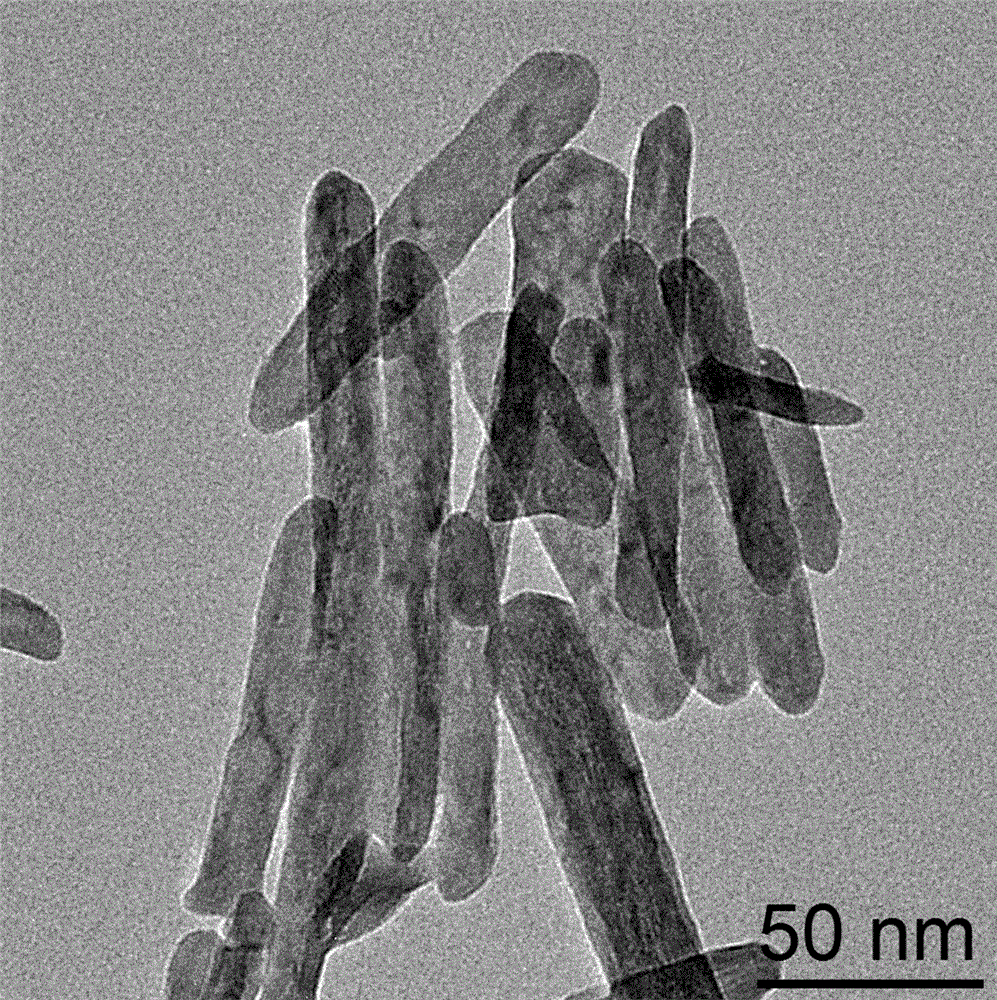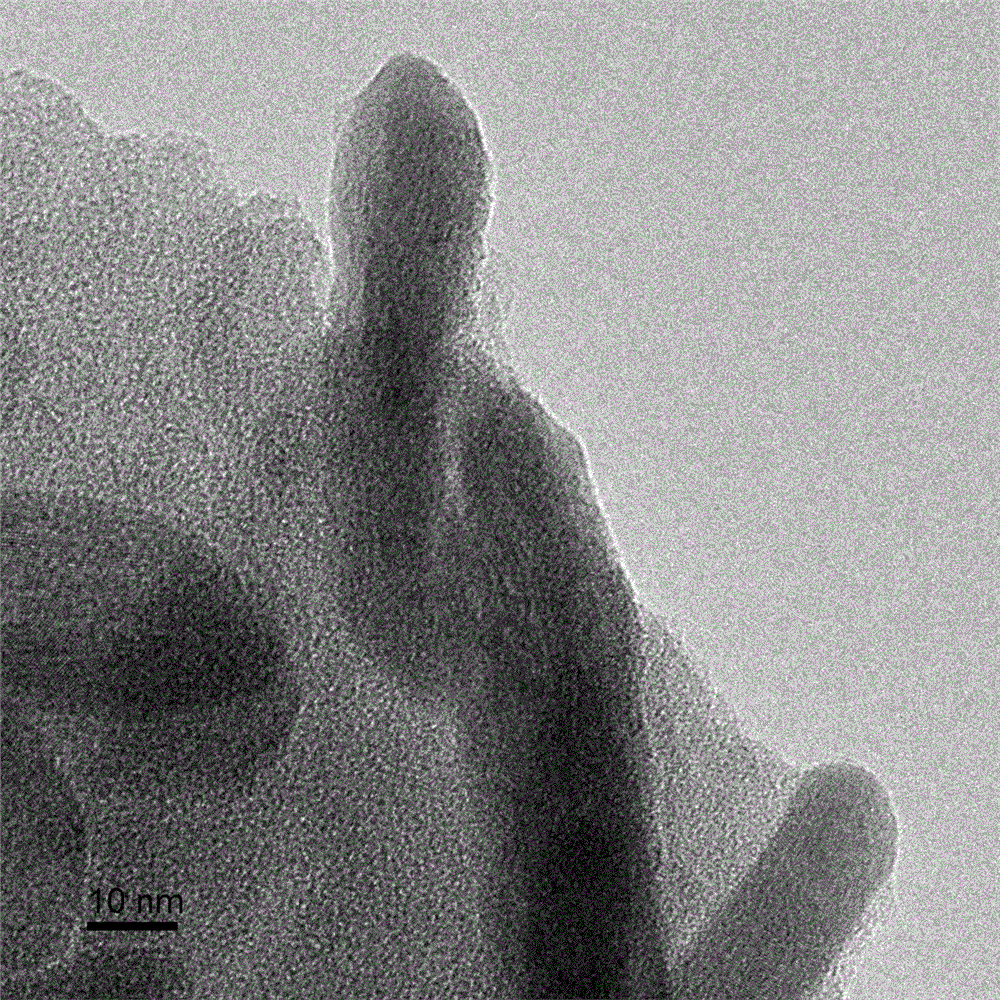Method for preparing gadolinium hydroxide nanorod with cerebral glioma targeting function
A brain glioma and gadolinium hydroxide technology, applied in the field of nanomaterials, can solve the problem of small size and achieve the effect of uniform size, good relaxation effect and simple process
- Summary
- Abstract
- Description
- Claims
- Application Information
AI Technical Summary
Problems solved by technology
Method used
Image
Examples
Embodiment 1
[0028] Dissolve 2.2568g gadolinium nitrate hexahydrate in 100mL deionized water, stir to form a uniform gadolinium nitrate solution, then add 1mmol / mL sodium hydroxide aqueous solution dropwise to the above-mentioned gadolinium salt solution and stir to adjust the pH to 13. Gadolinium hydroxide nanoparticles, continue to stir for a few minutes, place the reacted mixed solution A in a high-pressure reactor, and then react in an electric thermostat reaction oven at 180°C for 12 hours to obtain a white precipitate powder, and centrifuge the obtained white precipitate. Then wash three times with deionized water, and dry under vacuum at room temperature to obtain well-dispersed gadolinium hydroxide nanorods (i.e. Gd(OH) 3 NRs); ultrasonically disperse 200 mg of gadolinium hydroxide nanorods in 50 mL of a mixture of dimethyl sulfoxide and carbon tetrachloride B, then add 1 mL of aminopropyltriethoxysilane and 30 μL of deionized water in sequence, and the resulting mixture C stirred...
Embodiment 2
[0030] Dissolve 4.5136g gadolinium nitrate hexahydrate in 100mL deionized water, stir and disperse to form a uniformly dispersed gadolinium nitrate solution, then add 1mmol / mL sodium hydroxide aqueous solution dropwise to the above-mentioned gadolinium salt solution and stir to adjust the pH to 13, after the reaction Transform into gadolinium hydroxide nanoparticles, continue to stir for a few minutes, place the reacted mixed solution A in a high-pressure reactor, and then react in an electric constant temperature drying oven at 160°C for 12 hours to obtain a white precipitated powder, which is then centrifuged. and washed three times with deionized water, and dried under vacuum at room temperature to obtain well-dispersed gadolinium hydroxide nanorods (Gd(OH) 3 NRs); ultrasonically disperse 200 mg of gadolinium hydroxide nanorods in 50 mL of a mixture of dimethyl sulfoxide and carbon tetrachloride B, then add 1 mL of aminopropyltriethoxysilane and 30 μL of deionized water in s...
Embodiment 3
[0032] Dissolve 2.2568g gadolinium nitrate hexahydrate in 100mL deionized water, stir and disperse to form a uniformly dispersed gadolinium nitrate solution, then add 1mmol / mL sodium hydroxide aqueous solution dropwise to the above-mentioned gadolinium salt solution and stir to adjust the pH to 13, after the reaction Transform into gadolinium hydroxide nanoparticles, continue to stir for a few minutes, place the reacted mixed solution A in a high-pressure reactor, and then react in an electric constant temperature drying oven at 180°C for 6 hours to obtain a white precipitated powder, which is then centrifuged. and washed three times with deionized water, and dried under vacuum at room temperature to obtain well-dispersed gadolinium hydroxide nanorods (i.e. Gd(OH) 3 NRs); ultrasonically disperse 200 mg of gadolinium hydroxide nanorods in 50 mL of a mixture of dimethyl sulfoxide and carbon tetrachloride B, then add 1 mL of aminopropyltriethoxysilane and 30 μL of deionized water ...
PUM
| Property | Measurement | Unit |
|---|---|---|
| Diameter | aaaaa | aaaaa |
Abstract
Description
Claims
Application Information
 Login to View More
Login to View More - R&D Engineer
- R&D Manager
- IP Professional
- Industry Leading Data Capabilities
- Powerful AI technology
- Patent DNA Extraction
Browse by: Latest US Patents, China's latest patents, Technical Efficacy Thesaurus, Application Domain, Technology Topic, Popular Technical Reports.
© 2024 PatSnap. All rights reserved.Legal|Privacy policy|Modern Slavery Act Transparency Statement|Sitemap|About US| Contact US: help@patsnap.com










